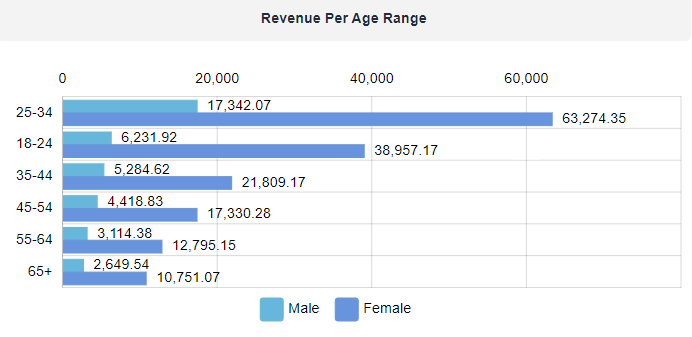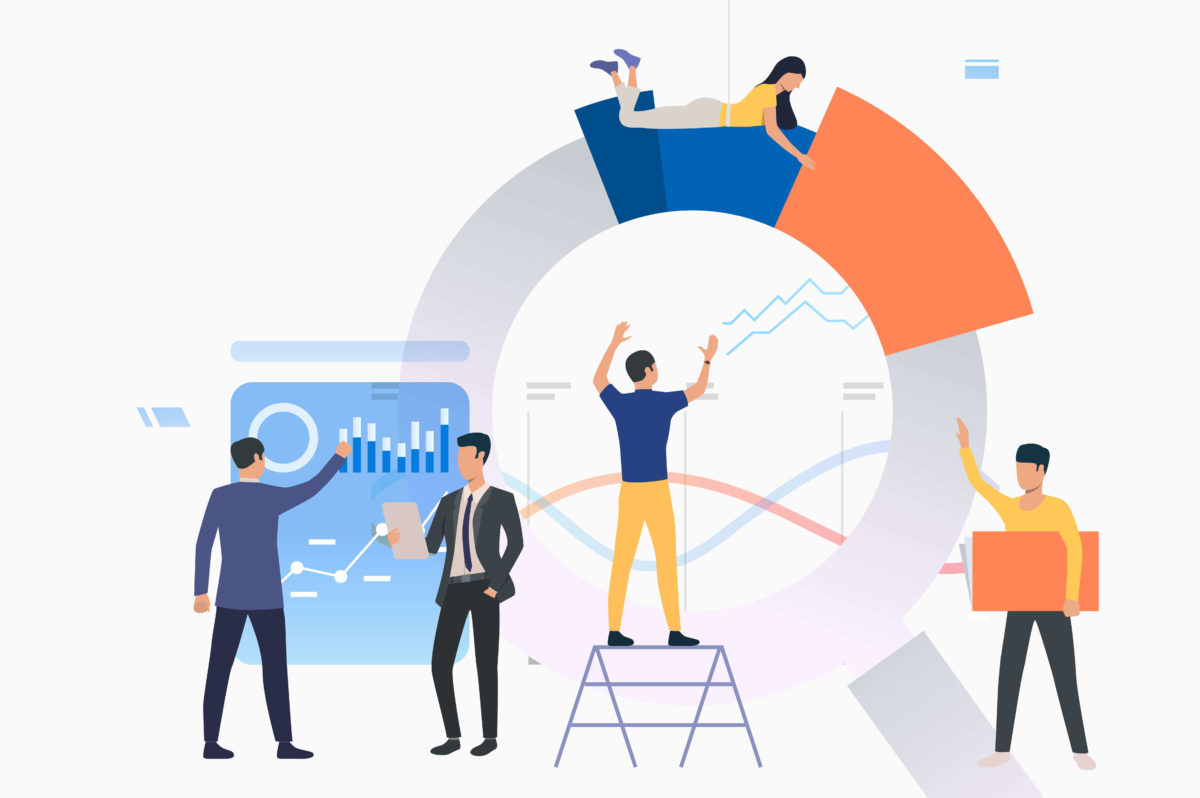Get more conversions: How to leverage demographics data with Ontrack Analytics
In today’s world, building a Shopify store is so easy, anyone can do a decent job at creating one. But creating the store is just a small piece of the puzzle. 95% of Shopify stores fail within a year. The real art lies in how you transform it into a successful business. So, how do we get there? How can we achieve a high number of conversions?
The short answer is: Tailoring your business to the people who you already know are most likely to buy your product and become satisfied clients. This is a great way to get more conversions. A customer-oriented mindset is the (overlooked) key to reaching your goals. Of course, you first have to know who your audience is. That’s why the demographic report exists: to give you better insights into who your customers are and to help you understand how much each segment means to your business.
A short guide on how to use the demographic report for segmenting your audience and scaling your e-commerce business
How do I use demographic reports to improve my business?
It’s easy to get lost in the immense pool of data in GA. With the purpose of offering a clear and easy solution, we have created a special analytics app, tailored to Shopify stores. Ontrack Analytics structures your GA data and turns it into answers and, most importantly, actionable insights.
In this article, I’m going to show you how to piece together key information about the demographics of your audience and fully leverage it to get the maximum amount of conversions. Let’s get started!
First things first, where can I find the demographic report in the Ontrack Analytics App? After you have logged in with the same Google address you use for your analytics account, select your desired Property and View. All you have to do now is to go to the left-side menu and, under Analytics Insight, you will find Demographics Insights.
When you get here, you’ll notice a lot of important data is now at your disposal. Keep in mind, all the data here is based on the gender and age of your total amount of traffic, in the selected time period.

How to use Ontrack Analytics to gain valuable insights
In order to give you valuable answers, we have structured the report in three parts:
I. Segments
These segments represent vital information for your business, so pay close attention to them.
- Biggest Demographic Segment – This shows you who represents the biggest portion of your total traffic.
- Highest Volume of Transactions – This shows you who has the highest number of transactions.
- Segment with Highest Revenue – This shows you who brings the biggest part of your revenue.
- Best Converting Demographic – This segment will show you who is the group of people with the highest conversion rate. It can signal untapped marketing opportunities.
- Highest Average Order – This shows you who buys the most expensive products.

II. Demographic Report
The second part allows you to dive deeper and gain an in-depth look at your audience’s demographics. Here is where you’ll find detailed reporting about the value of every specific group for your business.

III. Data Visualization
- Gender Distribution
- Revenue Per Gender
- User Per Age Range
- Revenue Per Age Range

What important insights can the demographics report tell me about my audience?
First of all, it can help you uncover the main characteristics that describe your audience and define the personas you’re addressing with your offer.
Age is probably the most basic and important indicator that can give you valuable insights about your audience. Consumer preferences, such as needs, wants and expectations constantly change with their age. This variable can be viewed as specific age ranges or life cycle stages: babies, children, teenagers, adults, middle-aged, and seniors. Further age-based analysis can help you identify the struggles and expectations your audience is currently facing. For example, many famous designers in the fashion industry have different collections that target different age groups. While ASOS targets a younger demographic, Hugo Boss addresses a totally different, more mature audience.
Another key way of putting this variable into perspective is to identify the generations your traffic belongs to. These groups of people were born around the same time in history, they grew up with similar kinds of experiences and presently share similar experiences. They have certain similar characteristics and thought processes. Take notes of key information and use it while conveying your message. This is proven to increase conversions.
Gender is crucial for the way in which your website communicates.
Naturally, men and women have distinctive behaviors, such as likes, dislikes, needs, and thought processes. Each has separate perceptions and outlooks about the way in which specific markets function. Successful businesses understand these differences in thought processes and cater to the specific needs of their markets. If you’re not taking this into consideration, you’re setting yourself up to fail, so make sure you make the most of it in order to maximize your conversions.
There’s a long list of products that are gender-focused. Here are a few examples: cosmetics, clothing, accessories, footwear, even mobile phones and automobiles.
More than that, unifying both dimensions gives you a clearer picture and allows you to structure your messaging in order to establish a long-lasting relationship with your customers and create deeper customer loyalty. This type of personalization helps customers identify with your brand. It also helps in reducing the risk of running campaigns towards uninterested consumers, thus increasing your ROI.
Another way in which you can use this information is by figuring out what channels are best suited for your message, in order to get maximum visibility and engagement.
Understanding the similarities and differences of your audience allows you to segment the market into individual categories and create tailored selling points accordingly.
Secondly, it can help you determine the most valuable segments of your audience.
Strategy is the key element in business. It’s what wins the game. A good strategy will turn you into a millionaire by simply selling rocks. A poor strategy will make a great product unsellable.
By identifying which segment of users gets more conversions, which has the highest average order value (AOV), and who brings the biggest amount of revenue, you can plan your strategy accordingly based on predictable behavior.
Finally, you can determine the least valuable segments of your audience.
There will always be people who are simply not interested in what you’re offering. This is something all businesses share, so don’t worry about it. Just make sure to exclude them from your overall strategy and create more precise and efficient campaigns.
Strategies for profitable use of the demographics report
Develop a strong content strategy for SEO visibility and engagement.
A smart content strategy will definitely take your business to the next level. Easier said than done, right?
But just knowing who your audience really is will give you insights as to who you are addressing and what they’re interested in. These bits of information are like indicators leading you to the city of relevant and engaging content. They help you generate ideas and develop a more relevant type of messaging that people actually care about. As you become more relevant, users will spend more time with you. And this is more powerful than just SEO visibility because it places your brand in their top-of-mind awareness.
Understanding your customers helps you know what tone you should be using when you’re addressing them. Good messaging makes the reader feel like you’re speaking directly to them, building a more intimate relationship between the customer and your brand.
Think about this for a second: a relevant change of your messaging can increase clicks by 400%. Source: CopyHackers
Another way to use this information is with your PPC campaigns. Here are three ways to do this:
- Target users who are most likely to buy (the segment with the highest conversion rate).
- Target high-value users (the segment with the highest revenue) – less conversions, more revenue and LTV.
- Exclude low-value users – Increase the efficiency of your campaigns and maximize ROI.
Customer journey optimization through A/B testing and evaluation.
Most probably, the top groups of customers with the highest value will share either gender or age. Here is some useful info about creating successful sales funnels.
Let’s imagine that your no.1 segment consists of Females, ages 24-35 and your second most valuable segment is represented by Females, ages 18-24. As you can imagine, young women will shop differently than Males, 45-54. So, it’s important that you keep this data in mind while designing your customer journey through the site. By doing proper research (What do young women need, like and trust? And how can I use this to provide a better shopping experience?) and using this technique correctly (testing the most relevant hypothesis), your conversion will gain amazing uplifts.
Improve customer retention and maximize lifetime value.
There’s no secret to it: acquiring new customers is expensive.
“Acquiring a new customer is anywhere from 5 to 25 times more expensive than retaining an existing one”. Source: Harvard Business Review
If you want to max out the profitability of your business, you have to think about more than just conversions. I’m talking about customer retention and lifetime value. Your current client base is easily the most important segment that you should focus on. Customer retention increases the lifetime value of your clients. But how do you retain clients efficiently?
These are people who trusted you enough to make at least one purchase. It’s essential to do research and find common characteristics and behaviors to better fit their needs, wants and expectations. It’s a great way to identify patterns
The good news is that this data is already in your account and ready to use. All you have to do now is connect your Google Analytics account to the Ontrack Analytics App and the rest should be a piece of cake.
Bonus: We’ll provide you with useful tips along the way.

Article takeaways:
- Discover the key characteristics that define your audience.
- Learn who represents the most valuable segment(s) for your business.
- Create a smart content strategy that perfectly matches your audience.
- Adjust the targeting of your campaigns and convert more visitors into customers.
- Optimize the customer journey through A/B testing and get the maximum amount of conversions.
